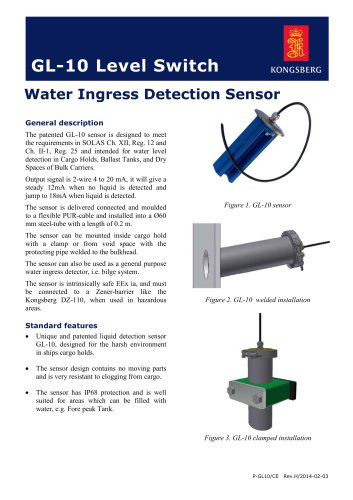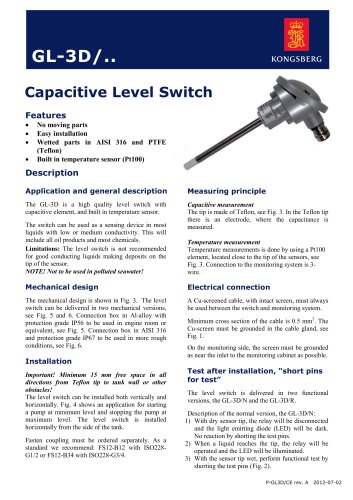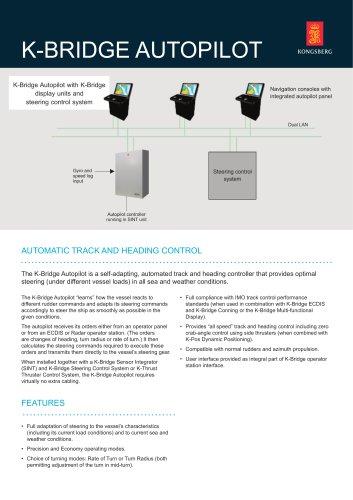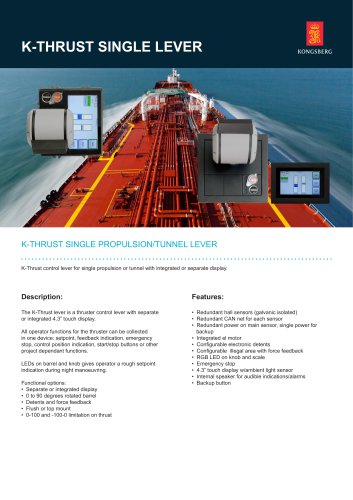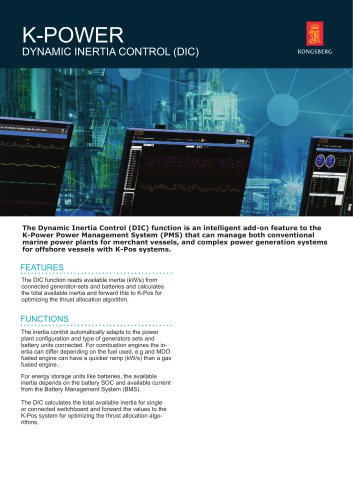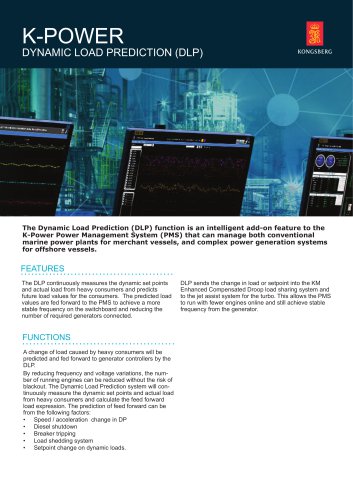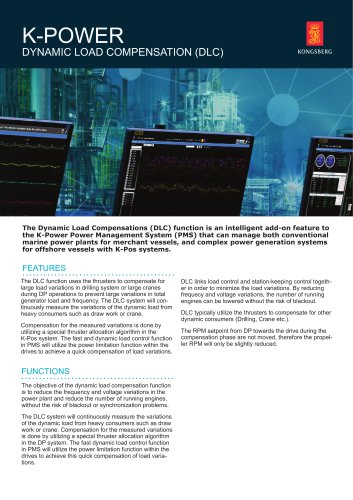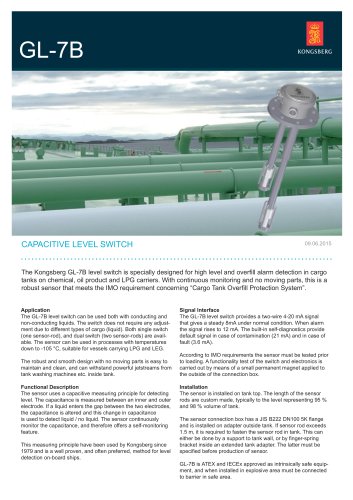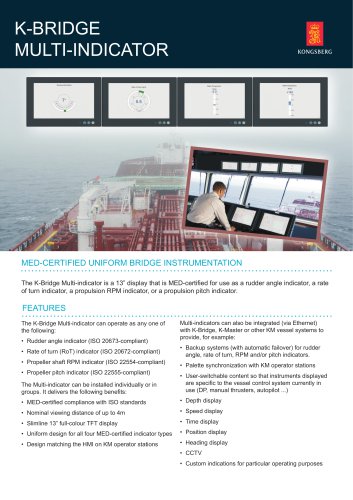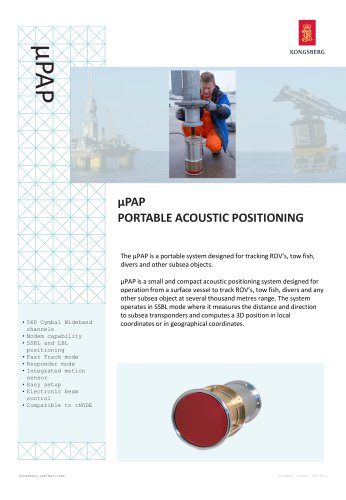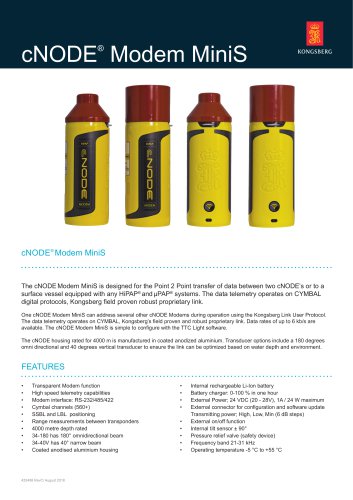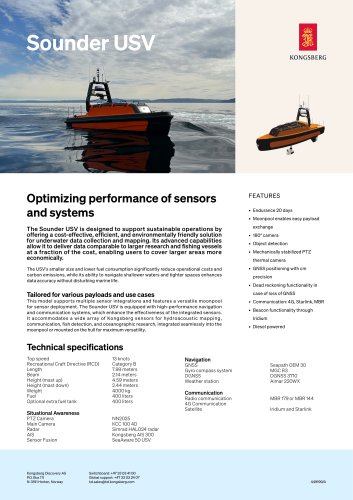
Catalog excerpts
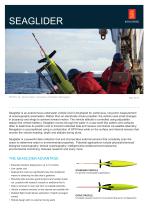
PHOTO: Dr. Vernon Asper, University of Southern Mississippi. Seaglider is an autonomous underwater vehicle (AUV) developed for continuous, long term measurement of oceanographic parameters. Rather than an electrically driven propeller, the vehicle uses small changes in buoyancy and wings to achieve forward motion. The vehicle attitude is controlled using adjustable ballast (the vehicle battery). Seaglider moves through the water in a saw-tooth like pattern and surfaces often to determine its position and to transmit collected data and receive commands via satellite telemetry. Navigation is accomplished using a combination of GPS fixes while on the surface and internal sensors that monitor the vehicle heading, depth and attitude during dives. Seaglider is a powerful data collection tool and incorporates external sensors that constantly scan the ocean to determine water or environmental properties. Potential applications include physical/chemical/ biological oceanography, tactical oceanography, intelligence/surveillance/reconnaissance, environmental monitoring, fisheries research and many more. THE SEAGLIDER ADVANTAGE • Extended duration deployment, up to 10 months • Low capital cost • Deployment costs are significantly less than traditional means of obtaining the data that is gathered STANDARD PROFILE For general oceanography applications • Resulting data provides good temporal and spatial scales not possible with research vessels or traditional AUVs • Data is retrieved in near real time via satellite telemetry • Vehicle is piloted remotely via the internet and satellite link • Detailed flight model allows estimation of depth averaged current • Robust design with no external moving parts OGIVE PROFILE Increased payload volume for more demanding sensor c
Open the catalog to page 1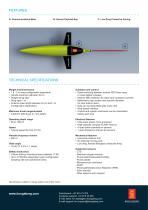
C: Low Drag Protective Fairing A: Communications Mast B: Sensor Payload Bay TECHNICAL SPECIFICATIONS Weight and Dimensions • 1.8 - 2 m long (configuration dependent) • Vehicle maximum diameter 30 cm • Weight 52 kg (dry) • Wing span 1 m • Antenna mast length between 43 cm and 1 m (configuration dependent) Maximum travel range/duration • 4,600 km (650 dives to 1 km depth) Operating depth range • 50 to 1000 m Speed • Typical speed 25 cm/s (0.5 kt) Variable buoyancy volume • 850 cc Glide angle • 16-45° (1:3.5 to 1:1 slope) Battery Endurance • Lithium Sulfuryl chloride primary batteries 17...
Open the catalog to page 2All Kongsberg Maritime catalogs and brochures
-
GL-10
2 Pages
-
GL-3D
4 Pages
-
K-Bridge AP
2 Pages
-
K-THRUST
2 Pages
-
GL-7B
2 Pages
-
K-BRIDGE MULTI-INDICATOR
2 Pages
-
μPAP
3 Pages
-
cNODE® Modem MiniS
2 Pages
-
Sounder
1 Pages
-
AutoChief 600
2 Pages
-
Hugin product specification
2 Pages
-
DP Operator Station-650
2 Pages
-
Compact DP Operator Station
2 Pages
-
Dynamic positioning systems
9 Pages
-
DP Logger
2 Pages
-
K-Thrust TC
4 Pages
-
K-Thrust RCS
2 Pages
-
cC-1
2 Pages
-
cJoy WT
2 Pages
-
cJoy OT
2 Pages
-
cJoy Controller
2 Pages
-
cJoy PE
2 Pages
Archived catalogs
-
EM 2040C MKII
2 Pages
-
DRS 500/IMS 500
2 Pages
-
The Seapath family
12 Pages
-
mini MRU
2 Pages
-
Vessel motion monitoring
2 Pages
-
Company brochure
19 Pages
-
The MRU Family of Products
16 Pages
-
company borchure 2019
13 Pages
-
MGC R2
2 Pages
-
DP alert system
2 Pages
-
Automatic DP alert
2 Pages
-
EELUME500
2 Pages
-
REMUS 6000
2 Pages
-
REMUS 600
2 Pages
-
Naval AUV product range
16 Pages
-
Munin AUV
2 Pages
-
SEAGLIDER C2
2 Pages
-
SEAGLIDER M6
2 Pages
-
HISAS 1030
12 Pages
-
Vessel performance optimizer
20 Pages
-
K-Chief Marine automation system
16 Pages
-
Dynamic Positioning Logger
2 Pages
-
KM-workboats-folder
4 Pages
-
KM OSV brochure
8 Pages
-
HiPAP Family brochure
24 Pages
-
K-Nav navigation products
8 Pages
-
REMUS catalog
8 Pages
-
OE14-408
2 Pages
-
OE14-110/111
2 Pages
-
oe15-108/109
2 Pages
-
OE15-110/111
2 Pages
-
Hugin family of AUV's
28 Pages
-
Motion Gyro Compass
2 Pages
-
Kongsberg GlobalSim
5 Pages
-
K-CHIEF 700
9 Pages
-
K-CHIEF 600
4 Pages
-
OE14-372/373
1 Pages
-
OE14-364/365
1 Pages
-
OE14-308
1 Pages
-
OE14-208
1 Pages
-
oe15-358/359
1 Pages
-
OE15-100c/101c
1 Pages
-
OE13-124/125
2 Pages
-
OE14-522
1 Pages
-
oe14-502
1 Pages
-
AIS 200
2 Pages
-
HPR 418
2 Pages
-
HPR 408S
2 Pages
-
RADius
2 Pages
-
DPC-3
2 Pages
-
DPC-1
2 Pages
-
OS-650-DP
2 Pages
-
DARPS 116
2 Pages
-
Offshore Support Vessels
8 Pages
-
Know exactly where you stand
4 Pages
-
Offshore support vessels
8 Pages
-
REMUS 100
6 Pages
-
The hydrographic product family
32 Pages
-
AIS 200 BF
2 Pages
-
GeoSwath Plus
16 Pages
-
Engine Room Simulator
16 Pages
-
Pressure sensors
5 Pages
-
Signal converters
5 Pages
-
Products for workboats
4 Pages
-
Products for tankers
32 Pages
-
LNG vessel automation
12 Pages
-
Cruise
20 Pages
-
Yacht brochure
12 Pages
-
K-MASTER WORKSTATION
12 Pages
-
cJoy system
2 Pages
-
AIS 200 P
2 Pages


